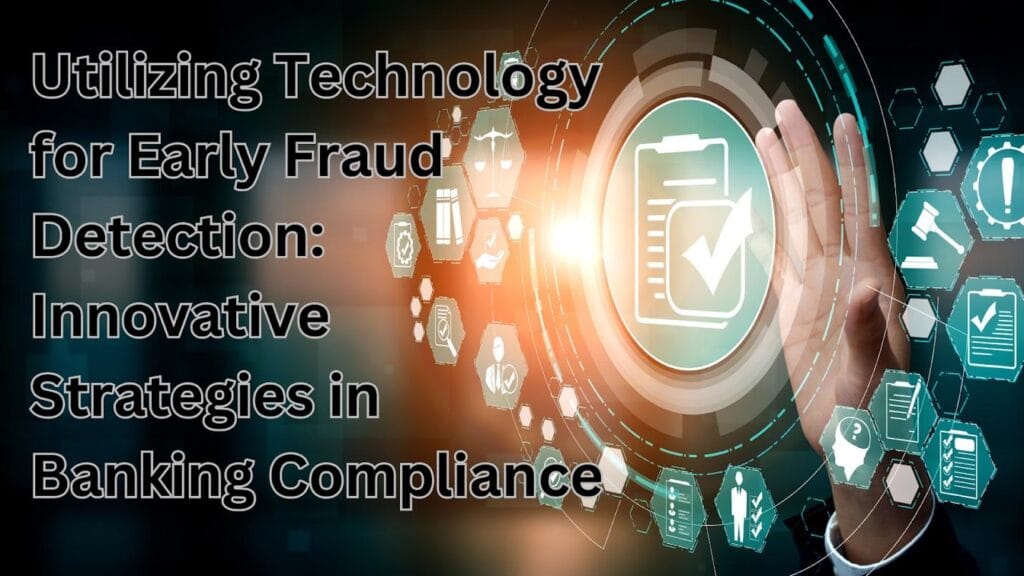In the dynamic realm of finance today, banks encounter unprecedented hurdles in combating fraud while upholding strict regulatory standards. With fraudsters employing increasingly intricate methods, conventional fraud detection approaches are proving inadequate. Hence, banks must embrace innovative technological solutions to maintain their integrity and stability while staying ahead of emerging threats.
This study delves into the crucial role of technology in early fraud detection within banking compliance management frameworks. Through harnessing state-of-the-art technologies like artificial intelligence (AI), machine learning (ML), biometric authentication, blockchain, advanced analytics, and cloud computing, banks can transform their anti-fraud strategies. These technologies empower banks to scrutinize vast datasets in real time, pinpoint patterns, and spot anomalies indicative of fraudulent behavior with unprecedented precision.

Furthermore, technology integration enables banks to streamline compliance risk assessment procedures, boost operational efficiency, and reinforce risk management protocols. Nonetheless, it’s vital to remember that technology alone cannot address all challenges. A comprehensive approach, encompassing robust governance structures, staff training, and collaboration with regulatory bodies and industry peers, is indispensable for establishing a resilient and efficient fraud detection and prevention environment.
Through examining innovative strategies, this article aims to offer insights into how banks can leverage technology to bolster their defenses, adhere to regulatory requirements, and uphold trust in the financial system amidst an ever-changing fraud landscape.
1. Artificial Intelligence and Machine Learning
Artificial Intelligence (AI) and Machine Learning (ML) have become essential tools in combating fraud. Through analyzing extensive datasets and detecting patterns and irregularities, these technologies can accurately identify potential fraudulent activities. Compliance management solutions can utilize AI and ML algorithms to constantly monitor transactions, track compliance, spot suspicious behavior, and issue alerts in real time.
One of the significant advantages of AI and ML is their capacity to learn and adapt to new fraud tactics. As fraudsters change their strategies, these technologies can adjust and improve their detection methods autonomously, ensuring that the bank’s defenses stay current and efficient. Additionally, AI and ML can aid in risk assessment by helping banks assign risk levels to customers, transactions, and accounts based on the likelihood of involvement in fraudulent actions.
2. Biometric Authentication
Biometric authentication methods like fingerprint scanning, facial recognition, and voice identification provide a strong security measure for preventing fraud. These technologies verify a person’s distinct biological features, ensuring the authentication of customers and thwarting unauthorized access to accounts or transactions.
In addition to boosting security, biometric authentication simplifies the customer journey by removing the necessity for complex password setups or knowledge-based authentication processes. Moreover, biometric data is extremely difficult to duplicate, serving as a potent deterrent against identity theft and fraudulent attempts to take over accounts.
3. Blockchain Technology
Blockchain, the foundational technology supporting cryptocurrencies such as Bitcoin, has demonstrated significant promise in improving transparency and security in financial dealings. By establishing an unalterable, decentralized ledger of transactions, blockchain offers a tamper-resistant record that can be scrutinized and tracked, greatly lessening the likelihood of fraud.
Financial institutions can utilize blockchain technology to securely manage and transfer confidential financial information, facilitating instantaneous verification and validation of transactions. This heightened visibility aids in the identification and prevention of fraudulent behaviors such as double-spending, money laundering, and unauthorized fund transfers. Furthermore, the dispersed structure of the blockchain enhances resilience against cyber threats and data breaches.
4. Advanced Analytics and Data Visualization
The banking sector accumulates extensive data, and efficiently utilizing this data is essential for detecting fraud promptly. Sophisticated analytics methods like predictive modeling and data mining can reveal concealed patterns and connections that might signal potential fraud situations.
Data visualization instruments are crucial for interpreting this intricate data. By presenting data in a visually engaging and user-friendly format, banks can spot trends, deviations, and irregularities more readily. Interactive dashboards and live monitoring systems empower compliance management solution teams to gain a comprehensive understanding of the bank’s risk exposure, enabling them to proactively address fraud risks.
5. Cloud Computing and Scalable Infrastructure
Implementing cloud computing and scalable infrastructure can greatly improve a bank’s capacity to promptly identify and address fraud. By harnessing the capabilities of cloud-based services, banks can tap into extensive computing resources as needed, allowing for more efficient processing and analysis of large datasets.
Cloud-based fraud detection systems can effortlessly adjust their capacity according to the bank’s requirements, ensuring resource utilization is optimized and expenses are controlled. Furthermore, cloud-based solutions facilitate collaboration and data exchange among various departments and branches, enabling a comprehensive approach to fraud detection and prevention.
6. Cybersecurity and Threat Intelligence
With the rising digitization of banking operations, the danger of cyber assaults and data breaches presents a notable threat. Strong cybersecurity protocols and adept threat intelligence capabilities are imperative for safeguarding sensitive financial information and upholding customer confidence.
Banks can utilize sophisticated threat intelligence systems to monitor and assess cyber threats as they occur. By remaining abreast of the newest attack methods and vulnerabilities, banks can take preemptive measures to fortify their defenses and deploy strategies to thwart potential breaches. Additionally, integrating cybersecurity standards like encryption, access management, and routine security evaluations can aid in reducing the risk of fraud stemming from cyber attacks.
7. Collaboration and Information Sharing
Improving fraud detection and prevention strategies relies greatly on cooperation and information exchange among banks, regulatory entities, and law enforcement. By combining resources and sharing insights, banks can gain a deeper insight into emerging fraud schemes and behaviors.
Through collaborative platforms and secure channels for sharing information, banks can exchange data related to fraud, helping them stay proactive against evolving threats. Moreover, partnerships with regulatory bodies and law enforcement agencies can assist in investigating and prosecuting fraudulent activities, serving as a deterrent and promoting a more robust culture of compliance automation throughout the banking sector.
Conclusion
As the banking sector grapples with increasingly intricate regulations and ever-changing fraud risks, embracing innovative technologies becomes not just an option but a necessity. Through harnessing AI, machine learning, biometric authentication, blockchain, advanced analytics, cloud computing, and robust cybersecurity measures, banks can establish a proactive and thorough approach to detecting and preventing fraud.
Nevertheless, it’s crucial to understand that technology alone isn’t a cure-all. A comprehensive strategy blending cutting-edge technologies with strong governance structures, employee training, and collaboration with industry peers is vital for constructing a resilient and compliant banking environment.
By staying ahead of the curve and continuously adapting to new challenges, banks can bolster their defenses against fraud, uphold customer trust, and preserve the integrity of the financial system. In the ever-evolving fight against fraud, embracing innovation and leveraging technology will be critical for success.
FAQs
- What role does technology play in early fraud detection within the banking sector?
- Technology enables banks to analyze vast amounts of data in real time, identify patterns, and detect anomalies indicative of fraudulent activities with unparalleled accuracy.
- How can artificial intelligence (AI) and machine learning (ML) contribute to improving fraud detection?
- AI and ML algorithms can analyze historical data to identify patterns and trends, enabling banks to predict and prevent fraudulent activities before they occur.
- What are some examples of innovative technological solutions used by banks for fraud prevention?
- Examples include biometric authentication, blockchain technology for secure transactions, advanced analytics for risk assessment, and cloud computing for real-time monitoring.











